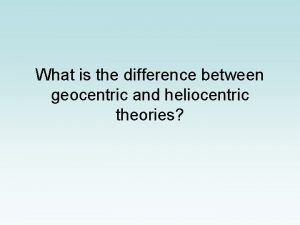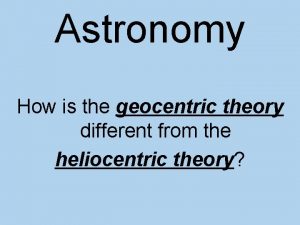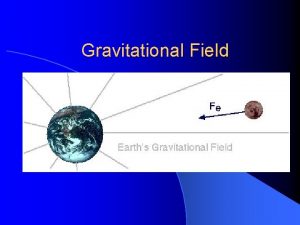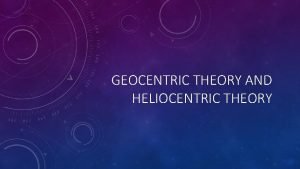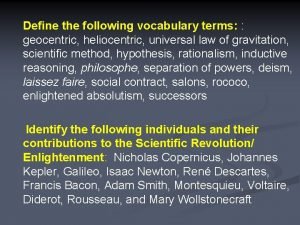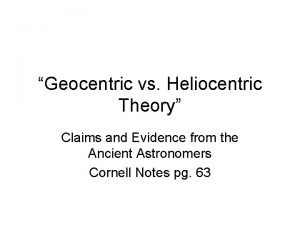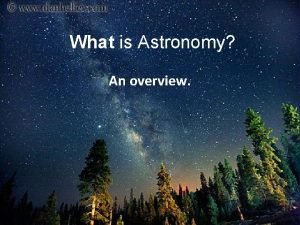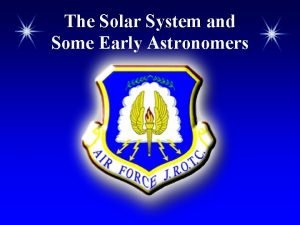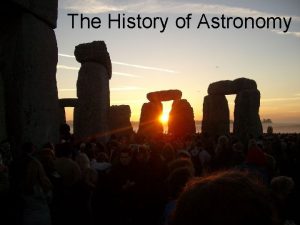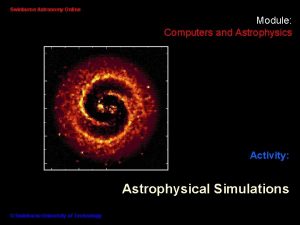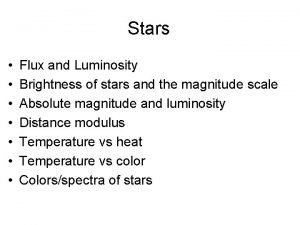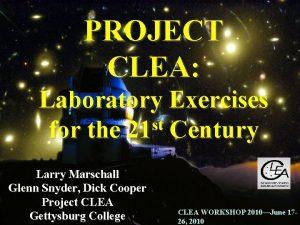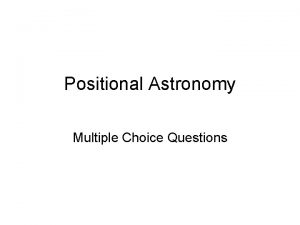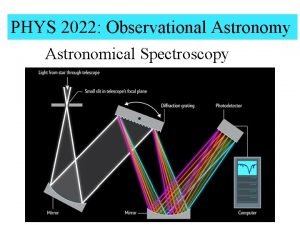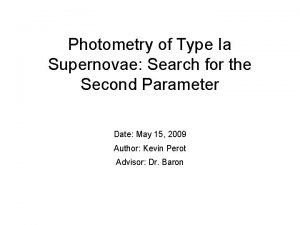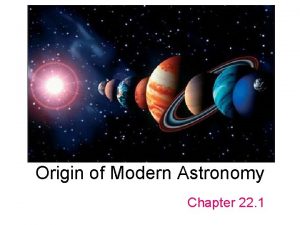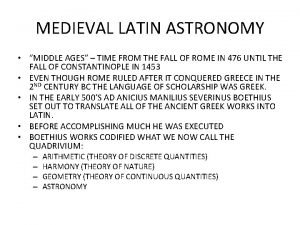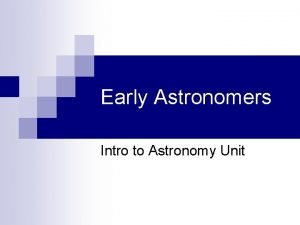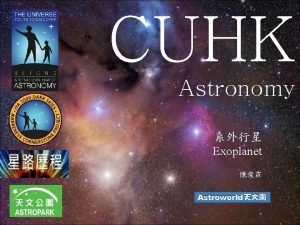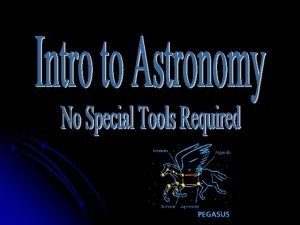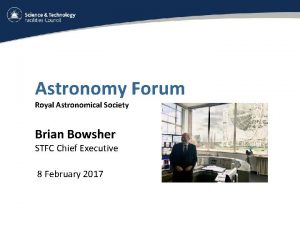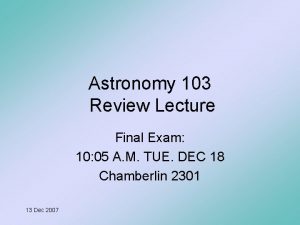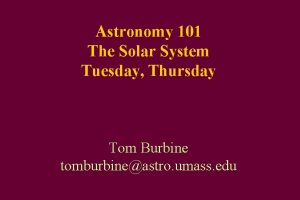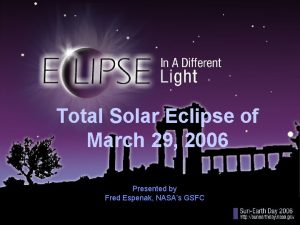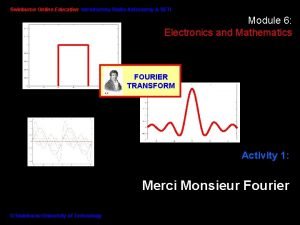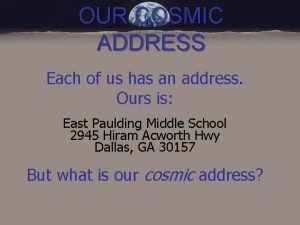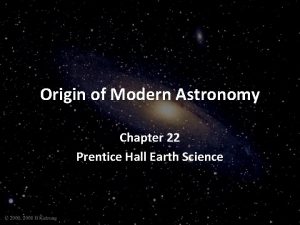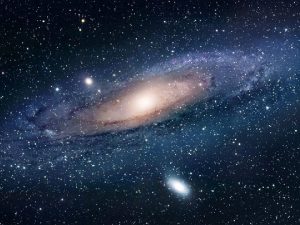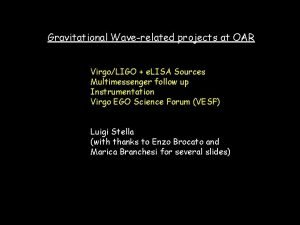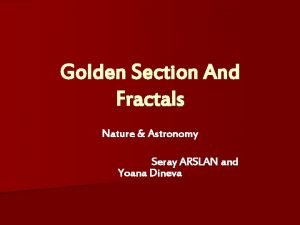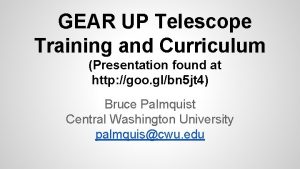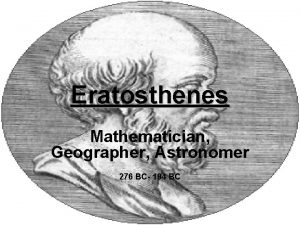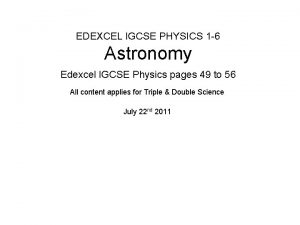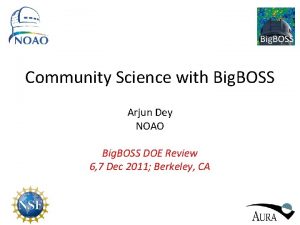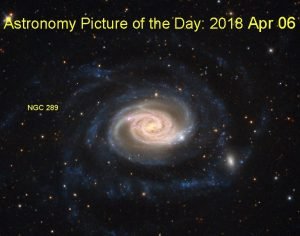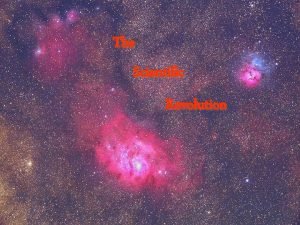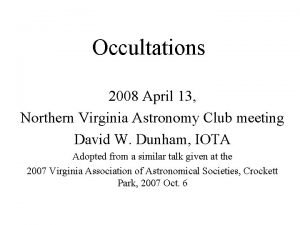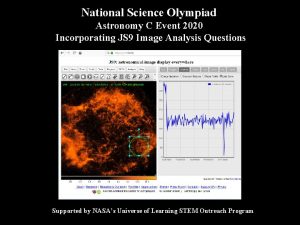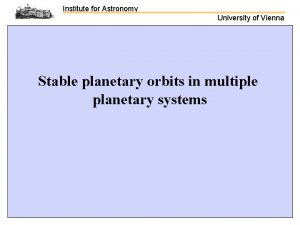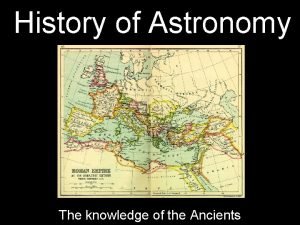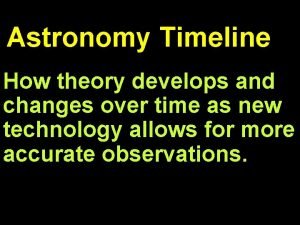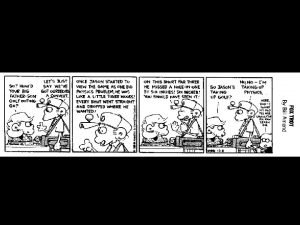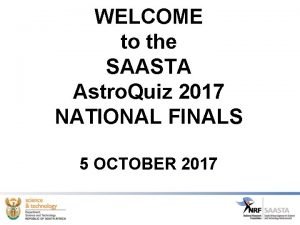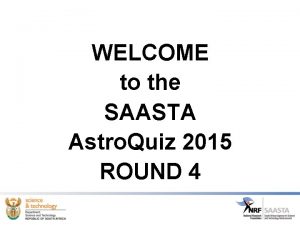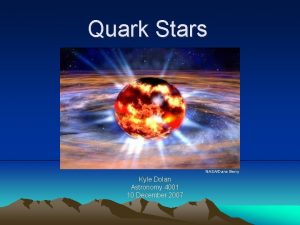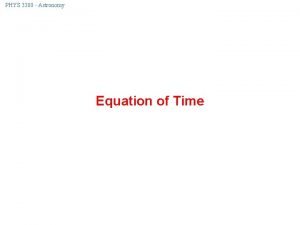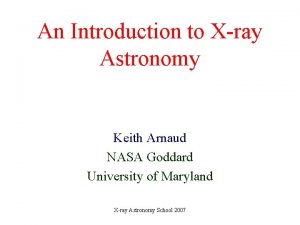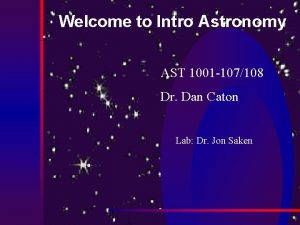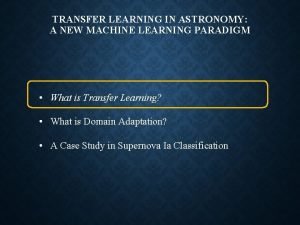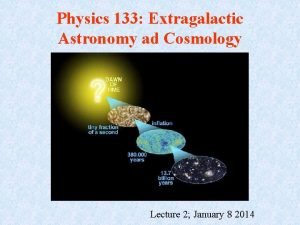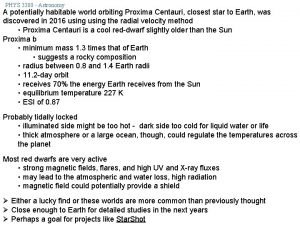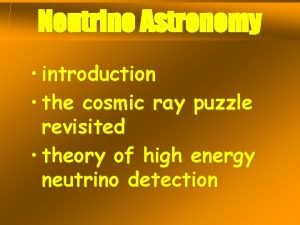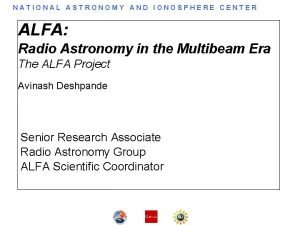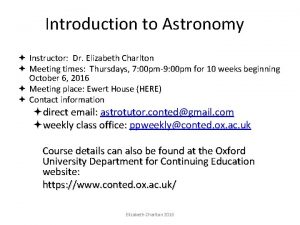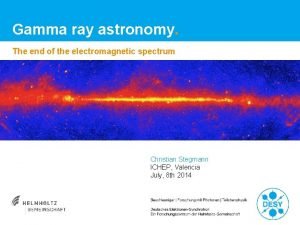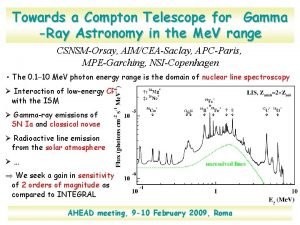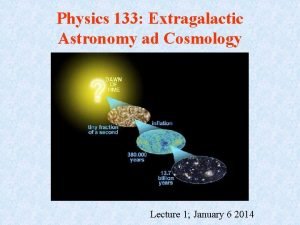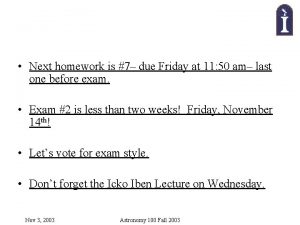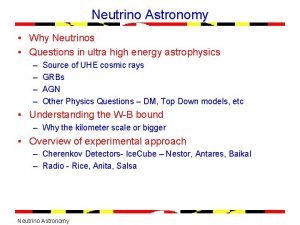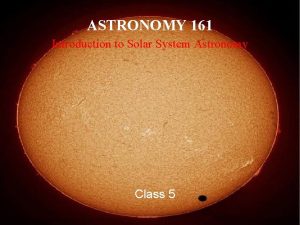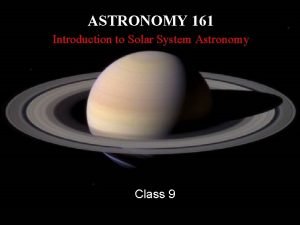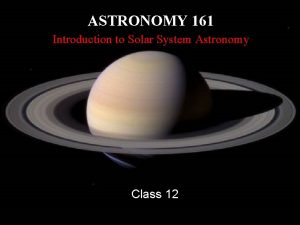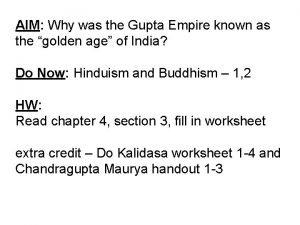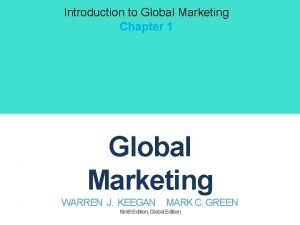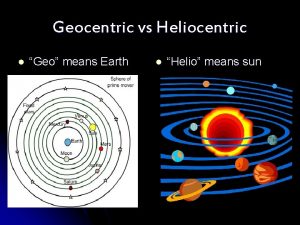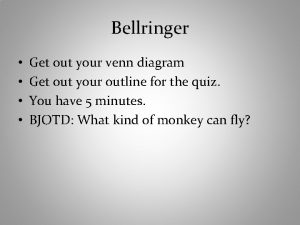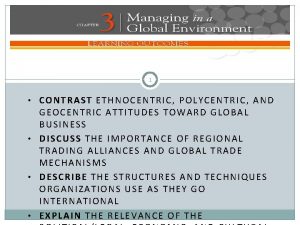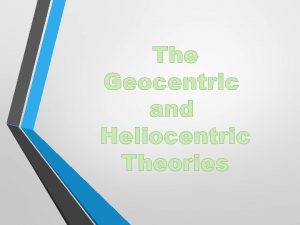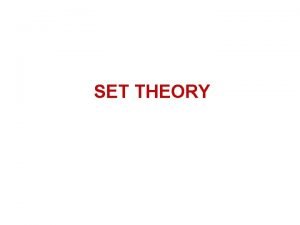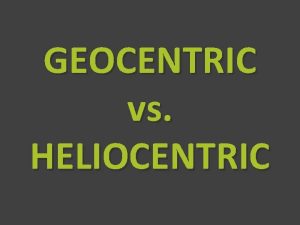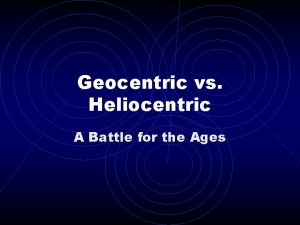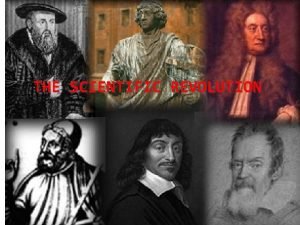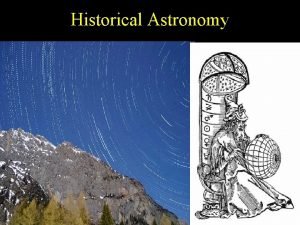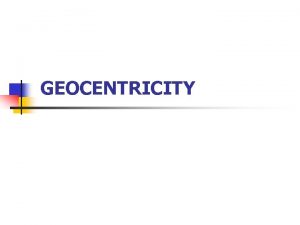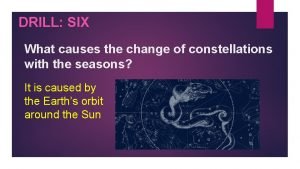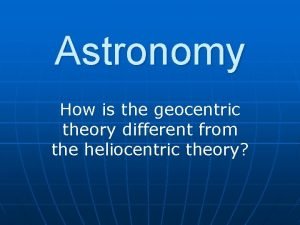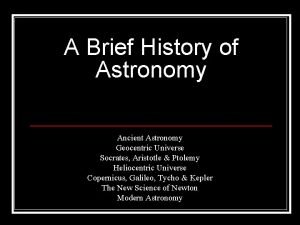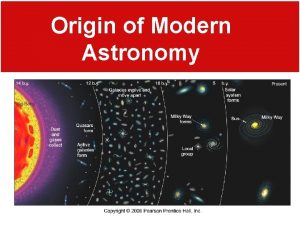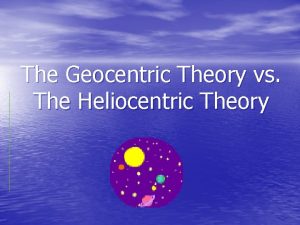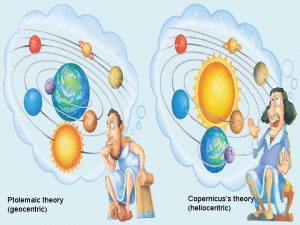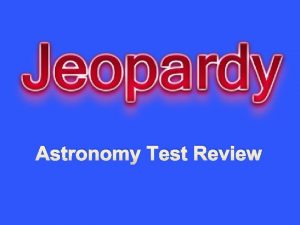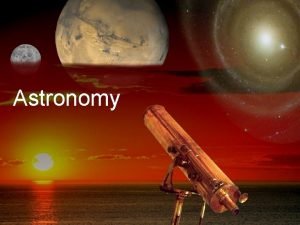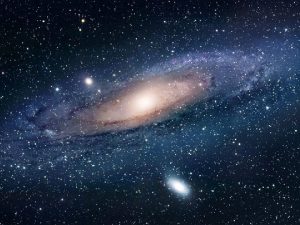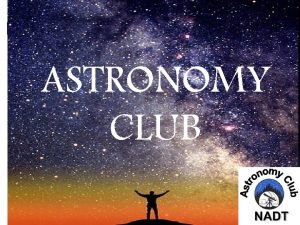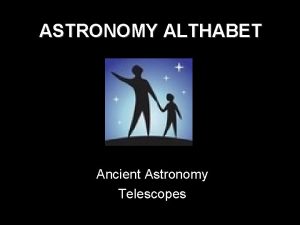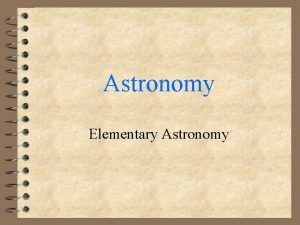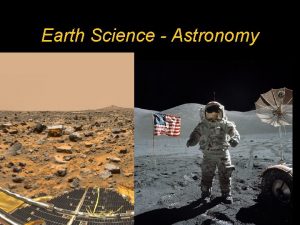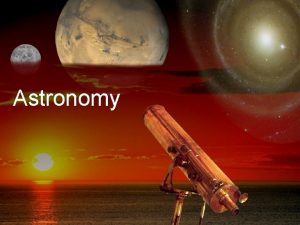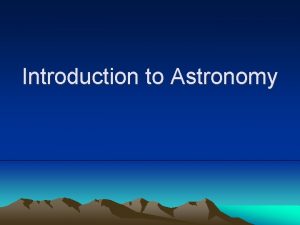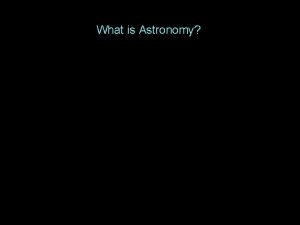Astronomy How is the geocentric theory different from


















































































































































- Slides: 146

Astronomy How is the geocentric theory different from the heliocentric theory?

The Formation of Our Solar System • • • Universe Big Bang Galaxies Nebula Orbits Solar System • Geocentric Theory • Heliocentric Theory • Galileo • Copernicus

How is the geocentric theory different from the heliocentric theory? • What do most scientists say produced the universe? • Compare and Contrast the geocentric theory and the heliocentric theory. • Who was Copernicus and what did he propose that was later supported by observations made by Galileo?

The Formation of Our Solar System • Most scientists believe that the universe began about 13. 5 billion years ago in a great explosion, called the Big Bang. • Matter from the explosion came together to form the first stars. • These stars were drawn together by gravity to produce family of stars, called galaxies.

A galaxy is a large group of stars, gas, and dust held together by gravity

There are three types of galaxies…. Elliptical, Irregular, and Spiral Can you guess which one is which?

Spiral Galaxy – a central bulge of older stars and arms that stretch outward like a wheel Elliptical Galaxy – has an oval shape with a bright center.

Irregular Galaxy – Galaxies that are not spiral or elliptical are considered irregular

We live in a spiral galaxy called the Milky Way Galaxy Our solar system lies on one of the outer arms called Orions Arm

The Formation of Our Solar System • Before our solar system, there was a giant cloud of gas and dust called a nebula • Something disturbed the nebula causing it to spin • As it spun, material clumped together. Intense heat and pressure created our sun • Grains of dust surrounding the sun collided over and over to form planets, moons, and comets in our solar system

What does a Nebula look like?

The Formation of Our Solar System • These objects revolve around the sun in paths called orbits. • Centuries ago, most people thought Earth was the center of the solar system, not the sun. This theory is called the geocentric theory. • The idea that the sun is the center of the solar system is called the heliocentric theory. • Copernicus was an astronomer. He suggested that the sun, not Earth, was the center of the solar system.

What is the Geocentric Theory? What does the prefix geo- mean? What does –centric mean? What do you think geocentric means?

Geocentric theory is… • Geocentric means earth centered. • A long time ago people thought Earth was the center of our solar system and everything revolved around it

What is the Heliocentric Theory? What does the prefix helio- mean? What do you think heliocentric means?

Heliocentric Theory means… • Heliocentric means sun centered • Copernicus was the first person to suggest that the sun was the center of the solar system • Galileo used telescopes to make observations that the sun was the center of the solar system

What did Galileo see? • First, Galileo invented a telescope and discovered 4 moons revolving Jupiter. • He concluded that not everything in the solar system revolved around Earth.

Jupiter and Her Four (4) Moons… Is this the image Galileo witnessed with his telescope over 500 years ago? This photo is what Galileo may have seen over five hundred years ago. Of course, there were no actual photos available that long ago…

What else did Galileo see ? • Then, Galileo found that Venus goes through phases like those of the moon, as predicted by Copernicus. • Galileo reasoned that this could happen only if Venus revolved around the sun, not around Earth.

View of Venus’ Phases (from Earth)

Quick Check Which happened MOST recently? a. b. c. d. the formation of the universe the formation of the solar system the formation of the sun the formation of the Milky Way

Quick Check Where in the Milky Way Galaxy is the solar system found? a. b. c. d. in an outer arm in its center in an inner arm outside the Milky Way’s outer edge

Quick Check The solar system is thought to have been formed from which of the following objects? a. the universe b. the milky way galaxy c. a nebula d. the sun

Quick Check Who was the person that made observations to support the Heliocentric Theory? a. b. c. d. Galileo Copernicus Isaac Newton Albert Einstein

Quick Check What did the geocentric theory state? a. The sun is at the center of the solar system. b. Earth is at the center of the solar system. c. The universe began with a great explosion. d. The earth revolves around a moon.

Quick Check Which object is the largest? a. Earth b. the sun c. the Milky Way Galaxy d. a star

Quick Check What was the FIRST discovery made by Galileo that supported Copernicus’ idea that the sun, not the earth, was at the center of the solar system? a. the discovery of Jupiter b. the discovery of some of Jupiter’s moons c. The discovery of the phases of Venus d. the discovery of the telescope

Quick Check What hypothesis was proposed by Nicolas Copernicus that was later supported by observations made by Galileo? a. b. c. d. The universe began with a Big Bang. Earth is the center of the solar system. The sun is the center of the solar system. The solar system is about 4. 5 billion years old.

Quick Check From the oldest event to the most recent event in the formation of the solar system, which is the correct sequence? a. b. c. d. nebula, Big Bang, sun Big Bang, nebula, sun, nebula, Big Bang, sun, nebula

Quick Check To what hypothesis does the Big Bang refer? a. an explanation of how the universe began b. an explanation of how the Milky Way Galaxy began c. an explanation of how the solar system began d. an explanation of how Earth began

The Position of Our Solar System Terms: Light year Astronomical Unit (AU) Milky Way Galaxy

Terms • Light year = 1 light year is the distance light travels in a year. • 1 light year = 9. 5 trillion km • Astronomical unit = 1 astronomical unit is the average distance between the sun and Earth (150, 000 km).

What is the position or location of our solar system? • How are distances measured in the solar system and the universe? (2) • Give a detailed description of the Milky Way Galaxy. (5) • Where is our solar system located? (2)


778, 000 What do you think this number means? money? # of people? Baseball players salary? # of hairs on your head?

778, 000 kilometers is the distance from the sun to Jupiter!

1 meter = 150, 000 km EX: 378, 000 km = 2. 8 150, 000 You need 2. 8 meters

Measuring Space A light year is the distance light travels in 1 year it is approximately 9. 5 trillion kilometers An Astronomical Unit (AU) is the average distance between Earth and the sun one AU is approximately 150, 000 kilometers

The Position of the Solar System • A light year is the distance light travels in a year. The most distant objects observed from Earth are about 13. 6 billion light years away. One (1) light year = 9. 5 trillion km. • Galaxies come in all sizes and shapes. The Milky Way Galaxy is shaped like a giant flattened disc with a bulge in the middle. • Spiral arms spin out into space from the Milky Way Galaxy’s center.

The Position of the Solar System • The Milky Way is about 100, 000 light years (9. 5 million trillion km) in diameter. • It is between 1000 to 3000 light years (9. 3 million billion km to 31. 0 million billion km) thick. • It is thickest at the center.

The Position of the Solar System • We live in a spiral galaxy called the Milky Way Galaxy • Our solar system lies on one of the outer arms called Orion’s Arm • An astronomical unit is the average distance between Earth and the sun. An astronomical unit is about 150, 000 km

The sun is about 30, 000 light years away from the center of the galaxy. It takes our solar system about 240 million years to circle the center of the galaxy.

Quick Check Where in the Milky Way Galaxy is the solar system found? a. In its center b. In an inner arm • c. In an outer arm d. Outside the Milky Way’s out edge

Quick Check What is an AU? a. The distance across the solar system b. The average distance from the sun to Earth c. The distance light travels in a year d. 10, 000 kilometers

Quick Check A light year is a unit of a. b. c. d. time. volume. speed. distance.

Quick Check If a space probe were able to move at half the speed of light, how long would it take the probe to travel from Earth to the center of the Milky Way Galaxy? a. 15, 000 years b. 30, 000 years c. 60, 000 years d. 120, 000 years

Quick Check Light travels about 300, 000 km a second. The sun is about 150, 000 km from Earth. About how long does light take to travel from the sun to Earth? a. 8 seconds b. 8 minutes c. 8 hours d. 8 years

Quick Check The nearest star outside our solar system is about 4. 2 light years away. About what distance would this be in kilometers? a. 40 trillion b. 400 trillion c. 4000 trillion d. 4 trillion

Terms: The Planets • Mercury • Venus • Earth • Mars » Pluto (Dwarf Planet) • Jupiter • Saturn • Uranus • Neptune

How are the planets alike and/or different? • What factors exists on Earth that make life possible here, but unlikely on any other planet? • Which planets in the solar system are called the “gas giants” and why? • In general, what condition on the planets is MOST affected by its distance from the sun?


The Planets • Earth’s atmosphere is about 78% nitrogen, 21% oxygen. • Liquid water, moderate temperature, and an atmosphere rich in oxygen make Earth the only planet that can support life as we know it. • The planets, Jupiter, Saturn, Uranus, and Neptune, are called the “gas giants. ” This is because they are so much larger than Earth and they do not have well defined surfaces. • The condition on the planets that is most affected by its distance from the sun is the temperature. The farther away they are from the sun, the lower the temperature on the planet.

• The planets that are much closer to the sun are classified as inner planets: Mercury, Venus, Earth, Mars – Inner planets have rocky, dense surfaces…. terrestrial planets • The planets that are much farther from the sun are classified as outer planets: Jupiter, Saturn, Uranus, Neptune – Outer planets are larger and composed of gas…. Gas giants • Pluto is a dwarf planet – it is not included in the outer planets group because it has different characteristics

The Inner Planets Also known as the “Terrestrial Planets” • Mercury • Venus • Earth • Mars

Mercury • closest planet to the sun • only Pluto is smaller • rocky surface with many craters • very thin atmosphere • high temperature • no life; Distance from the sun 58, 000 km Diameter 4, 880 km Year Length (Earth Years) 88 days Gravity (X Earth’s) 0. 38 Moons 0

Venus • 2 nd planet from sun • same size as Earth • rocky surface • atmosphere is very thick with carbon dioxide • gas traps heat under it • no life; Distance from the Sun 108, 000 km Diameter 12, 100 km Year Length (Earth Years) 225 days Gravity (X Earth’s) 0. 91 Moons 0

Earth • 3 rd planet from sun • surface is rocky • covered with plains, valleys, mountains, plateaus, active volcanoes • ¾ surface covered with water, • atmosphere 78% nitrogen, 21% oxygen • water, moderate temperature, and oxygen makes Earth only planet supporting life Distance from the Sun 150, 000 km Diameter = 12, 760 km Length of Year = 365. 25 days Gravity = 1 Moons = 1

Mars • 4 th planet from the sun, called “red planet”, • half the size of Earth, rocky and dusty surface, hills, plains mountains, extinct volcanoes, craters, • largest volcano in solar system, • ice caps north and south poles, • may have had water at one time, • thin atmosphere with carbon dioxide, • life may have existed at one time; Distance from the Sun 228, 000 km Diameter 6, 790 km Year Length (Earth Years) 687 days Gravity (X Earth’s) 0. 38 Moons 2

The Outer Planets “Gas Giants” • Jupiter • Saturn • Uranus • Neptune *No solid surfaces to walk upon*

Jupiter • 5 th planet from sun, • largest planet, • “gas giants" • no solid surface, • slushy ball of liquid hydrogen, • atmosphere mostly helium and hydrogen gases, • large red spot ( gigantic storm or hurricane), • circled by very thin rings, • no life; Distance from the Sun 778, 000 km Diameter 143, 000 km Yea Length (Earth Years) 119 years Gravity (X Earth’s) 2. 53 Moons 63

Saturn • 6 th planet from sun, • complex ring system, • second largest planet, • structure similar to Jupiter, • atmosphere is hydrogen and helium gases, • no life; Distance from the Sum 1, 427, 000 km Diameter 120, 500 km Year Length (Earth Years) 29. 4 years Gravity (X Earth’s) 1. 14 Moons 47

Distance from the Sun 2, 871, 000 km Diameter 51, 100 km • blue-green color from poisonous methane Year Length (Earth Years) 84 years Gravity (X Earth’s) 0. 9 • 7 th planet from sun Moons 27 Uranus • third largest planet • surface completely covered with water, methane, and ammonia • 11 rings circle planet • rotates on its side • poles point toward and away from sun, extremely cold temperature, • no life;

Neptune • 8 th planet from the sun, • fourth largest planet, • glows blue-green with methane gas clouds, • icy ocean of water, methane, ammonia, and hydrogen, • six rings orbit planet, • no life on planet; Distance from the Sun 4, 498, 000 km Diameter 49, 500 km Year Length (Earth Years) 165 years Gravity (X Earth’s) 1. 14 Moons 13

Quick Check Which planets in the solar system are called the gas giants? a. b. c. d. Mercury, Venus, Earth, Mars Saturn, Uranus, Neptune, Pluto Jupiter, Saturn, Uranus, Neptune Earth, Venus, Pluto, Mars

Quick Check Which is the current and correct model of our solar system? a. b. c. d. The Big Bang Theory The Geocentric Theory The Pythagorean Theory The Heliocentric Theory

Quick Check What three factors exist on Earth that make life possible here, but unlikely on any other planet? A. liquid water, moderate temperatures, atmospheric oxygen B. liquid water, moderate temperatures, atmospheric nitrogen C. liquid water, moderate size of Earth, atmospheric oxygen D. solid water, moderate temperatures, atmospheric oxygen

Quick Check Which planet is MOST LIKELY to support life as we know it? A. Mercury B. Venus C. Jupiter D. Mars

Quick Check In general, what condition is MOST affected by its distance from the sun? A. size B. temperature C. atmosphere D. surface composition

Quick Check The force of gravity on a planet determines the weight of objects on the planet. If you weighted 30 kg (66 pounds) on Earth, what would you weigh on Jupiter? A. 11. 4 kg (5. 2 pounds) B. 30 kg (66 pounds) C. 34. 2 kg (75. 4 pounds) D. 75. 9 kg (167. 3 pounds)

Objects’ Motion in the Sky Terms: Rotation Axis Day Year Constellation Revolution

Why do the sun and moon seem to move each day? • What causes day and night? • What causes the constellations to appear to be in different positions at different times of the year? • Compare and contrast rotation and revolution.

Rotation • Earth’s rotation on its axis causes day and night. • Rotation means spinning. Earth’s spinning on its axis is called its rotation. Earth makes one complete spin about every 24 hours. One complete spin is called a day. • It takes 24 hrs for the Earth to make one complete spin on its axis. If the earth’s rotation slowed, a day would be longer.

Earth’s Rotation • Earth rotations (spins like a top) on its axis, moving from west to east. • If this is correct, then why does it take longer (time) to fly from Atlanta to Los Angeles ((5 hrs) then it takes to fly from Los Angeles to Atlanta (3. 5 hrs)? • Because of the Jet Stream, my little grasshopper!

Revolution • In addition to rotating on its axis, Earth travels around the sun. The movement of one object around another object is called revolution. • One complete revolution around the sun is called a year. Earth’s path as it revolves around the sun is called its orbit. • As it travels around the sun, Earth’s orbit is not a circle, it is elliptical, like a slightly flattened circle, or oval shape.

Earth’s Revolution • Earth’s revolution (to move around an another object) around the sun • It takes 365. 25 days for Earth to make one (1) complete revolution around the sun. • When do we experience leap year (366 days) and why?

Constellations • Earth spins around its axis from west to east. This makes objects in the sky appear to be moving from east to west. • Another kind of motion of Earth, revolution, explains how stars and groups of stars called constellations change positions from month to month. • A constellation is a group of stars that ancient people pictured as mythological characters, animals, and other objects.

Back of Classroom <Leo>

Rotation vs. Revolution • Rotation is the spinning of an object around its axis. An axis is an imaginary line that runs through the earth, from the North Pole to the South Pole. • Earth makes one complete spin on its axis about every 24 hours. • Revolution is the movement of one object around another object. • Earth takes 365. 25 days to make one complete revolution around the sun. • Both rotation and revolution involve the movement of Earth.

Quick Check • What motion makes objects in the sky seem to rise in the east and set in the west? a. revolution of Earth b. rotation of Earth c. revolution of the sun d. rotation of the sun

Quick Check • What does one revolution of Earth equal? a. b. c. d. an hour a day a month a year

Quick Check • Around what does Earth rotate? • • A. its axis B. the sun C. the stars D. constellations

Quick Check • What motion of Earth makes it seem as if the stars and constellations are in different positions at different times of the year? • A. Earth’s rotation • B. the rotation of the stars and constellations • C. the revolution of the stars and constellations • D. the revolution of Earth

Quick Check • If Earth’s rotation slowed, which of the following would happen? • A. The stars would not seem to change position. • B. The length of a day would increase. • C. The length of a day would decrease. • D. The length of a day would still be about 24 hours.

Gravity Terms • Gravity Inertia • Orbits Ellipse

How do the planets remain in their orbits ? • What two factors keep the planets in their orbits? • What is gravity? • What is inertia? • What two factors does the strength of the pull of gravity depend upon?

Gravity • All objects, from the atom to the largest family of stars, possess gravity. • Gravity is a force that attracts all objects towards each other. • The strength of the pull of gravity between two objects depends on two factors. • These two factors are the product of the masses of the objects and the distance between them.

Gravity • As the product of the masses increases, the pull of gravity also increases. • If the distance between the two objects increases, then the pull of gravity between them decreases. • All objects in our solar system travel around the sun in paths called orbits. • Planets orbit around the sun, and moons are in orbit around planets.

Gravity • Scientist Sir Isaac Newton discovered 3 Laws of Motion. • His 1 st Law of Motion states that an object in motion will tend to stay in motion at the same speed and direction unless acted on by an outside force. • The tendency of objects to keep doing what they were doing is called inertia.

Gravity • Inertia tends to lead planets to follow a straight path at a certain speed unless acted on by an outside force. This outside force is the gravity of the sun. • While the gravity of the sun pulls the planet towards it, the speed and direction (inertia) of the planet pushes it forward. • When the forces of gravity and inertia are balanced, the planet follows a curved path around the sun.


Quick Check What force keeps Earth in orbit around the sun? a. a pull by one object that is in contact with another object. b. a push by one object that is in contact with another object. c. mass d. gravity

Quick Check What affects the force of gravity between two objects? a. the product of their masses and the distance between them b. only the distance between them c. only the sum of their masses d. the mass of the larger object

Quick Check In what direction does an object in space tend to move? a. in a curved path b. inward c. in a straight line d. backward

Quick Check How would the force of gravity between Earth and the sun be affected if the mass of Earth were greater than it is? a. The force of gravity would be unchanged. b. The force of gravity would be greater. c. The force of gravity would be less. d. There would be no force of gravity.

Quick Check If the force of gravity between Earth and the sun were greater than Earth’s inertia, what would happen to Earth? a. Earth would escape into space. b. Earth would fall into the sun. c. Earth would remain in its orbit around the sun. d. Earth would stop moving.

Comets, Meteors, and Asteroids Oh My!! Terms: Comet Coma Nucleus Tail Meteoroid Meteorite Asteroid

S 6 E 1. f Describe the characteristics of comets, asteroids, and meteors

• In the distant parts of our solar system, comets are dust covered rocks made of ice and rock • These dust covered rocks of ice and rock are called a nucleus • Something disturbs the comets and sends them streaking toward the sun!

• As the nucleus passes the orbit of Jupiter, it begins to heat up. • Some of the ice inside the nucleus turns to glowing gas • The gasses spread out from the nucleus to form an atmosphere around the nucleus called a coma • Together, the coma and the nucleus form the head of the comet

• As the comet approaches the sun, energy from the sun blows parts of the coma away from the nucleus…. . • These parts stream away from the head of the comet to form a shimmering tail • A comets tail ALWAYS points away from the sun

Nucleus Tail Coma Head

• Some comets plunge into the sun, and others orbit around the sun one or more times • The most famous returning comet is Halley’s Comet, which comes back approximately every 76 years • Can you see where the nucleus, coma, and tail are? • Judging from this picture, where is the sun?

Asteroids are chunks of rock and metal, much smaller than Earth’s moon

• Asteroids orbit the sun like planets • Most asteroids are found in a belt between the orbit of Mars and Jupiter • The largest known asteroid is Ceres (940 km in diameter) • Most asteroids are less than 1 km in diameter

Meteoroids, Meteors, and Meteorites • Between 1, 000 and 10, 000 tons of space rock fall to Earth each day…… when it is in space these rocks are called meteoroids • Meteoroids are made of rocky materials, and metal

• When a meteoroid plunges into Earth’s atmosphere it is known as a meteor • In Earth’s atmosphere, the meteor can get so hot that some or all of it burns up. • The burning meteor appears as a streak of light …… A Shooting Star

• If a meteor does not completely burn up in our atmosphere, it will hit Earth’s surface. • When a meteoroid hits Earth’s surface it is known as a meteorite Worlds largest meteorite Hoba, found in Namibia

• • Myskillstutor. com Username: lunch # Password cobb Site: floyd 05 • Press Math and Science • Then Science I • Earth Science

Draw the sequence that a meteoroid goes through……….

Quick Check In which direction does a comets tail always face? a. b. c. d. In the direction of the sun Away from the sun Perpendicular to the sun All different directions

Quick Check What is a comets coma? a. b. c. d. The stony and icy center of the head A chunk of iron A stream of gas at its back The atmosphere around its nucleus

Quick Check Where are most asteroids found? a. b. c. d. All over our solar system In orbit between Mars and Jupiter Near Earth Outside of the solar system

Quick Check What is the sequence that describes a space rock that falls to Earth’s surface? a. b. c. d. meteoroid, meteorite Meteor, meteoroid, meteorite Meteorite, meteoroid Meteor, meteorite, meteoroid

The Phases of the Moon Terms • Phases = one of the different shapes of the moon as seen from Earth • Waxing = bright part of the moon increase in size as time passes • Waning = bright part of the moon decreases in size as time passes.

How does the moon change phases? • What causes the phases of the moon? • What are the 8 names of the phases of the moon? • Since the moon does not produce light, how can you see it?

The positions of the moon, sun, and Earth determine which phase the moon is in. This photo shows how the moon looks from Earth at each phase.

Phases of the Moon

The Phases of the Moon • The changing shapes of the moon we see are called phases. The phase of the moon you see depends on how much of the sunlit side of the moon faces Earth. • The moon shows all of its phases in a cycle that lasts 29. 5 days. • The names of the moon’s 8 phases in order of appearance are: new moon, waxing crescent, first quarter, waxing gibbous, full moon, waning gibbous, 3 rd (last) quarter, waning crescent. • Since the moon does not produce light, light from the sun reflects off the moon, enabling it to be seen from Earth.

The Phases of the Moon • Waxing means “increasing in size” • Waning means “decreasing in size” • The moon does not produce its own light. It reflects sunlight in all directions. • During a new moon, the moon is between the sun and Earth, so you cannot see the moon.

The Phases of the Moon • After a few days, as the moon orbits Earth, it is no longer between the sun and Earth. • A little part of the moon’s face reflects sunlight toward Earth= waxing (increasing) crescent. • When half of the moon’s bright side faces Earth, it is a first quarter moon. • During a waxing gibbous, most of the moon’s lighted side faces Earth.

The Phases of the Moon • When the moon is half way through its cycle, the side that faces Earth is opposite of the sun. Earth sees all of the moon’s bright face. This is called a full moon. • As the cycle continues, we see less and less of the bright side of the moon. • In decreasing order, waning gibbous, third quarter moon, waning crescent. • After 29. 5 days, the cycle is complete. Another new moon has appeared.

Information (Food) for Thought…

Spring Tides happen during a Full moon and a New moon…

Oh! I see what happens… and neap tides happen in the 1 st quarter and 3 rd quarter of the moon’s phases!

Again!

Quick Check The position of what objects is responsible for the moon’s phases? A. only Earth B. only the moon and Earth C. only the moon and the sun D. the moon, Earth, and the sun

Quick Check About how long does it take the moon to complete one cycle of phases? A. one day B. one week C. one month D. one year

Quick Check Which is the correct order of the moon’s phases? A. waxing crescent, waning crescent, first quarter B. waning gibbous, last quarter, waxing gibbous C. full moon, new moon, first quarter D. waxing gibbous, full moon, waning gibbous

Quick Check How much of the moon’s surface can you see during a new moon phase? A. none B. one-quarter C. one half D. all of it

Quick Check What phase of the moon would you see about three weeks after a new moon? A. full moon B. waning gibbous C. last quarter D. the next new moon

Website Instructions • Go to www. enchantedlearning. com • Press Astronomy • Press the Moon • Press Phases of the Moon 1. Why does the shape of the moon appear to change ? 2. Define crescent moon, gibbous moon, half moon, and new moon 3. How does the moon rise and set ? 4. How does the moon rise and set at full moon ?

Solar and Lunar Eclipse Terms • Lunar eclipse solar eclipse • Total eclipse partial eclipse

Material Collection • 1. Phases of the Moon Pre. Quiz • 2. Phases of the Moon Notes • 3. Oreo Moon Phases Lab

How does Earth, the moon, and the sun align during a solar eclipse and lunar eclipse? • What causes solar and lunar eclipses? • Why do lunar eclipses occur only at a full moon? • Why do solar eclipses occur only at a new moon? • Why is there not a solar or lunar eclipse every month?

Solar and Lunar Eclipses • A solar and lunar eclipse occurs only when the earth, moon, and sun are directly lined up. • There are two types of eclipses. • The moon goes dark during a lunar eclipse. • The sun goes dark during a solar eclipse.

Lunar Eclipse • A lunar eclipse occurs when Earth passes directly between the sun and the moon. The Earth casts a shadow on the moon. • A lunar eclipse can happen only during full moon. • This is because it is the only time when Earth, the sun, and the moon are directly lined up with the Earth between the moon and the sun.

Lunar Eclipse

Solar Eclipse • A solar eclipse occurs when the moon passes directly between the sun and Earth • The moon casts a shadow on a part of Earth’s surface. • A solar eclipse can happen only during a new moon. • This is because it is the only time when Earth, the sun, and the moon are directly lined up with the moon between Earth and the sun.

Solar Eclipse


Solar and Lunar Eclipses • There is not a lunar or solar eclipse every month because the moon is not always on the same plane as Earth and the sun. • The moon orbits Earth at an angle. • An eclipse can be total or partial. • A total eclipse occurs when the moon or sun becomes completely covered. • A partial eclipse occurs when the moon or sun becomes only partly covered.

Quick Check Under what conditions will an eclipse take place? a. only when the sun and Earth are directly lined up b. only when the moon and Earth are directly lined up c. only when the moon, the sun, and Earth are not exactly lined up d. only when the moon, the sun, and Earth are directly lined up

Quick Check What phase must the moon be in to allow for a lunar eclipse? a. new b. full c. first quarter d. waxing gibbous

Quick Check Although the moon is much smaller than the sun, it looks about the same size when viewed from Earth. What fact might account for this observation? a. The moon is farther from Earth than the sun. b. Earth is closer to the sun than the moon c. The moon is closer to Earth than the sun. d. The moon shines brighter than the sun

Quick Check What conditions would produce a partial eclipse of the moon? a. the moon is on the same plane as the sun and Earth b. the moon is below the plane of the sun and Earth c. the moon is far above the plane of the sun and Earth d. none of the above

Quick Check When Earth’s shadow falls on the moon, the shadow causes a a. new moon. b. solar eclipse. c. full moon. d. lunar eclipse.
 Learning astronomy by doing astronomy
Learning astronomy by doing astronomy Learning astronomy by doing astronomy
Learning astronomy by doing astronomy Learning astronomy by doing astronomy
Learning astronomy by doing astronomy Heliocentric vs geocentric
Heliocentric vs geocentric Geocentric vs heliocentric model
Geocentric vs heliocentric model Difference between geocentric and heliocentric model
Difference between geocentric and heliocentric model Geocentric theory facts
Geocentric theory facts Define the geocentric theory
Define the geocentric theory Define geocentric theory
Define geocentric theory Geocentric theory definition world history
Geocentric theory definition world history Why do different polymers have different properties?
Why do different polymers have different properties? Flame test principle
Flame test principle Sound will travel at different speeds in different mediums.
Sound will travel at different speeds in different mediums. Examples of a medium in waves
Examples of a medium in waves Cultural relarivism
Cultural relarivism Different angle different story
Different angle different story Acids and bases song
Acids and bases song Manufactured boards examples
Manufactured boards examples We are all different but the same
We are all different but the same Venn diagram different same different
Venn diagram different same different Hát kết hợp bộ gõ cơ thể
Hát kết hợp bộ gõ cơ thể Frameset trong html5
Frameset trong html5 Bổ thể
Bổ thể Tỉ lệ cơ thể trẻ em
Tỉ lệ cơ thể trẻ em Voi kéo gỗ như thế nào
Voi kéo gỗ như thế nào Glasgow thang điểm
Glasgow thang điểm Hát lên người ơi alleluia
Hát lên người ơi alleluia Môn thể thao bắt đầu bằng từ chạy
Môn thể thao bắt đầu bằng từ chạy Thế nào là hệ số cao nhất
Thế nào là hệ số cao nhất Các châu lục và đại dương trên thế giới
Các châu lục và đại dương trên thế giới Cong thức tính động năng
Cong thức tính động năng Trời xanh đây là của chúng ta thể thơ
Trời xanh đây là của chúng ta thể thơ Mật thư anh em như thể tay chân
Mật thư anh em như thể tay chân 101012 bằng
101012 bằng Phản ứng thế ankan
Phản ứng thế ankan Các châu lục và đại dương trên thế giới
Các châu lục và đại dương trên thế giới Thơ thất ngôn tứ tuyệt đường luật
Thơ thất ngôn tứ tuyệt đường luật Quá trình desamine hóa có thể tạo ra
Quá trình desamine hóa có thể tạo ra Một số thể thơ truyền thống
Một số thể thơ truyền thống Cái miệng bé xinh thế chỉ nói điều hay thôi
Cái miệng bé xinh thế chỉ nói điều hay thôi Vẽ hình chiếu vuông góc của vật thể sau
Vẽ hình chiếu vuông góc của vật thể sau Thế nào là sự mỏi cơ
Thế nào là sự mỏi cơ đặc điểm cơ thể của người tối cổ
đặc điểm cơ thể của người tối cổ Thế nào là giọng cùng tên?
Thế nào là giọng cùng tên? Vẽ hình chiếu đứng bằng cạnh của vật thể
Vẽ hình chiếu đứng bằng cạnh của vật thể Vẽ hình chiếu vuông góc của vật thể sau
Vẽ hình chiếu vuông góc của vật thể sau Thẻ vin
Thẻ vin đại từ thay thế
đại từ thay thế điện thế nghỉ
điện thế nghỉ Tư thế ngồi viết
Tư thế ngồi viết Diễn thế sinh thái là
Diễn thế sinh thái là Dạng đột biến một nhiễm là
Dạng đột biến một nhiễm là Thế nào là số nguyên tố
Thế nào là số nguyên tố Tư thế ngồi viết
Tư thế ngồi viết Lời thề hippocrates
Lời thề hippocrates Thiếu nhi thế giới liên hoan
Thiếu nhi thế giới liên hoan ưu thế lai là gì
ưu thế lai là gì Sự nuôi và dạy con của hươu
Sự nuôi và dạy con của hươu Khi nào hổ con có thể sống độc lập
Khi nào hổ con có thể sống độc lập Hệ hô hấp
Hệ hô hấp Từ ngữ thể hiện lòng nhân hậu
Từ ngữ thể hiện lòng nhân hậu Thế nào là mạng điện lắp đặt kiểu nổi
Thế nào là mạng điện lắp đặt kiểu nổi What is astronomy
What is astronomy Claudius ptolemy astronomy contributions
Claudius ptolemy astronomy contributions Aristotle astronomy
Aristotle astronomy Swinburne astronomy
Swinburne astronomy Mizar luminosity
Mizar luminosity Difference between flux and luminosity
Difference between flux and luminosity Clea vireo
Clea vireo Astronomy questions and answers multiple choice
Astronomy questions and answers multiple choice Phys2022
Phys2022 Distance ladder astronomy
Distance ladder astronomy Origin of modern astronomy
Origin of modern astronomy Astronomy in the middle ages
Astronomy in the middle ages Geology earth science definition
Geology earth science definition Claudius ptolemy astronomy contributions
Claudius ptolemy astronomy contributions Cuhk astronomy
Cuhk astronomy Astronomer vs astrologer
Astronomer vs astrologer Astronomy forum uk
Astronomy forum uk Astronomy 103 final exam
Astronomy 103 final exam Astronomy 101 formulas
Astronomy 101 formulas Astronomy science fair projects
Astronomy science fair projects Astronomy picture of the day march 29 2006
Astronomy picture of the day march 29 2006 Time domain astronomy
Time domain astronomy Antwrp
Antwrp Astronomy what is our cosmic address
Astronomy what is our cosmic address Tycho brahe believed that
Tycho brahe believed that Netherlands institute for radio astronomy
Netherlands institute for radio astronomy Radio astronomy lectures
Radio astronomy lectures Astronomy picture of the day
Astronomy picture of the day Time domain astronomy
Time domain astronomy Seray arslan
Seray arslan Telescope training
Telescope training 194 bc
194 bc Igcse physics
Igcse physics Michigan state astronomy
Michigan state astronomy Time domain astronomy
Time domain astronomy Astronomy picture of the day 17 april 2001
Astronomy picture of the day 17 april 2001 Astronomy 161
Astronomy 161 Tycho brahe astronomy
Tycho brahe astronomy Northern virginia astronomy club
Northern virginia astronomy club Js9 imaging analysis software
Js9 imaging analysis software Astronomy
Astronomy Astronomy in ancient rome
Astronomy in ancient rome Astronomy timeline project
Astronomy timeline project Ast121
Ast121 Astro quiz 2021 questions and answers
Astro quiz 2021 questions and answers Saasta astro quiz
Saasta astro quiz Ebit
Ebit Quark astronomy
Quark astronomy Astronomy
Astronomy What are the branches of natural science
What are the branches of natural science Byu physics minor
Byu physics minor Astronomy
Astronomy Ast 1001
Ast 1001 Deep learning spectroscopy
Deep learning spectroscopy V zc astronomy
V zc astronomy Astronomy
Astronomy Astronomy
Astronomy Ionosphere
Ionosphere Elizabeth charlton
Elizabeth charlton Astronomy
Astronomy Astronomy
Astronomy Extragalactic astronomy
Extragalactic astronomy Hydrostatic equilibrium
Hydrostatic equilibrium Astronomy
Astronomy Astronomy 161
Astronomy 161 Solar system astronomy class
Solar system astronomy class Solar system astronomy class
Solar system astronomy class Astronomy gupta empire
Astronomy gupta empire Chat hull
Chat hull Geocentric supporters
Geocentric supporters Example of ethnocentric orientation
Example of ethnocentric orientation Geocentric marketing
Geocentric marketing Internet l
Internet l Venn diagram of geocentric and heliocentric
Venn diagram of geocentric and heliocentric Polycentric attitude
Polycentric attitude Heliocentric vs geocentric venn diagram
Heliocentric vs geocentric venn diagram Geocentric and heliocentric compare and contrast
Geocentric and heliocentric compare and contrast Heliocentric vs geocentric venn diagram
Heliocentric vs geocentric venn diagram Who made
Who made Geocentric vs heliocentric
Geocentric vs heliocentric Geocentric model
Geocentric model Geocentric model
Geocentric model Geocentric model
Geocentric model Geocentricity
Geocentricity Geocentric drilling
Geocentric drilling




